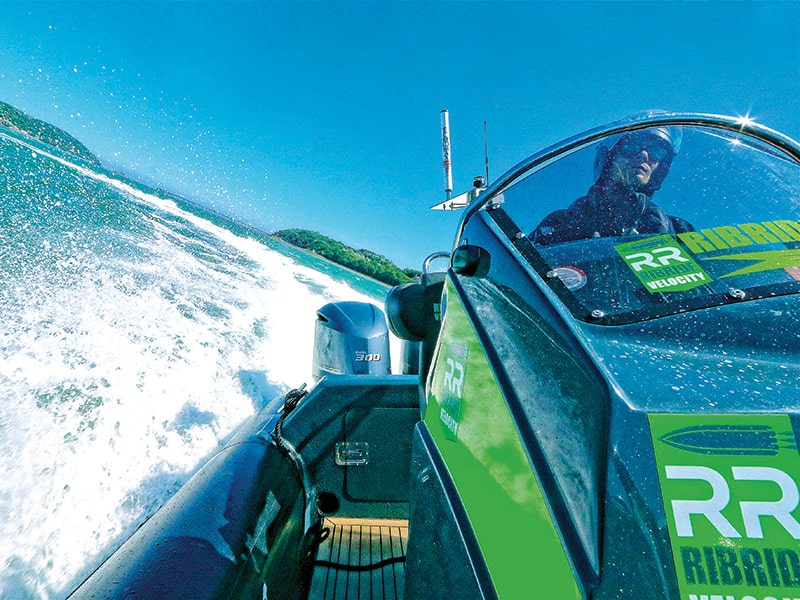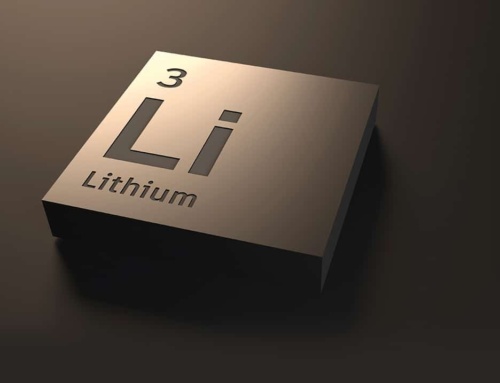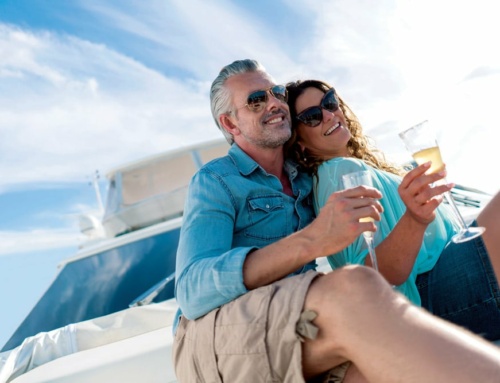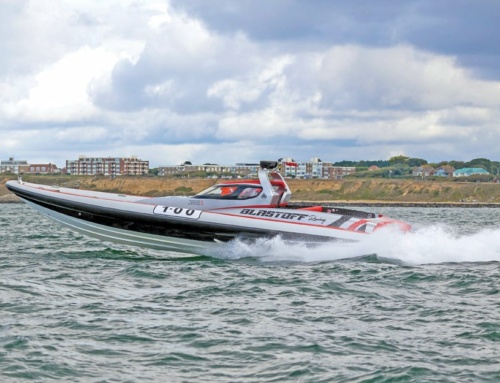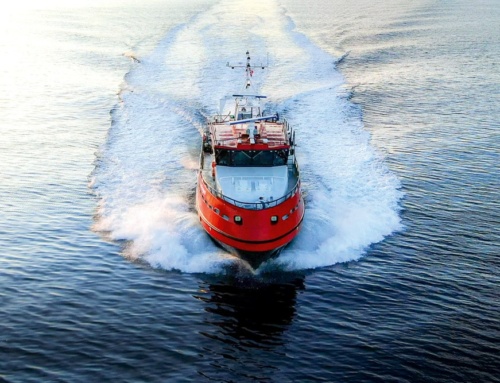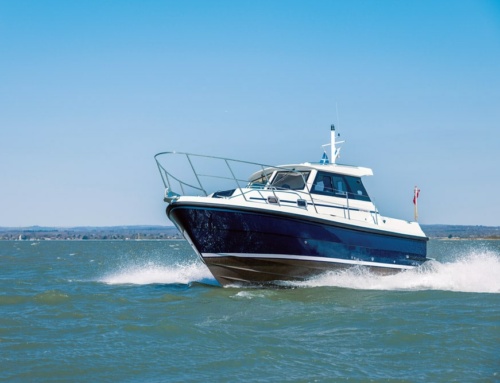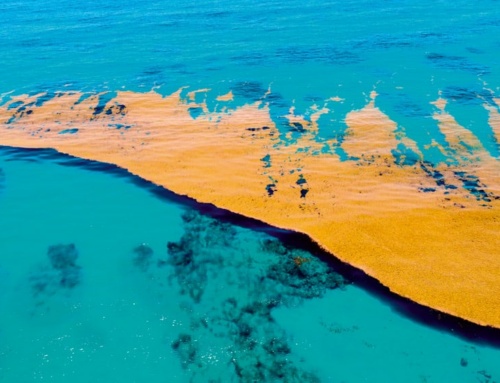- Frankly, Velocity’s mode of travel over such troubled water was in a different league to almost everything I have encountered before.
- The hull was slicing through the waves rather than taking them on ‒ no bangs, creaks or buffeting on the way to 70 knots.
- There was none of that nodding-off-course, juddering-cavitation or falling-out-of-the-turn malarkey I have endured on other RIBs …
Alex Whittaker discovers that nearly a thousand horses on the transom delivers true enlightenment …
In boat design, as in life, occasionally the stars align. Sometimes a truly exceptional vessel is conceived, and providing its design is painstakingly executed, the whole can become even greater than the sum of its impressive parts. Velocity is such a vessel.
Design mission
The back story to this innovative RIB is interesting. Noted adventure boat operator (and much else besides) RibRide wanted a new vessel for fast passages around Anglesey and the Menai Strait. As Tom Ashwell of RibRide told me, their design mission went much further than merely going fast safely with a full complement of fare-paying passengers:
‘We wanted to have a better answer for our customers to the much asked question: “How fast did we go?” We went out to the industry requesting a fully coded RIB that could operate at 80mph in challenging waters for up to seven hours a day, all year round. In many cases we were met with raised eyebrows and told it could not be done. Even the builders of the known “fast” RIBs looked sheepish. When asked the question, Graeme at Ribquest took us seriously. Two weeks later he had a proposal ready.’
Meet Velocity
Tom’s words resonated when I got my first look at Velocity. Her basic design components include:
- a tough but sleek 11.8m hull
- 3 x 300hp fly-by-wire Yamaha outboards
- a Gill bracket to mount the outboards
- shock-mitigating pilot and navigator seats (Scot Seat S2Js).
- Garmin multifunction nav display
- Yamaha engine display
- a large deck designed to take 12 passenger seats
- a small forward storage cuddy
There are other features, of course, but these are the basic elements. However, no list prepares you for the slingshot performance, assured seakeeping and sheer presence of this hugely impressive RIB.
Design mission
Put simply, Velocity was designed and built by Ribquest for their client RibRide. So Velocity began with a clean CAD screen and a series of focused practical objectives. The design method turned out to be an interactive process. RibRide also worked closely with Yamaha engines and the design house at Ribquest to come up with a secure, practical, high-performance design that would satisfy all the necessary commercial ‘coding’ to carry passengers at high speed. However, given their own long experience in boat specification, as well as commercial passenger boat operation, RibRide brought other things to the table. As Tom also told me, it comes down to balance:
‘Balance is the root of everything. In multihulls we design and balance hulls to produce as little pitching as possible. Velocity is no different: we are able to keep the waterline even regardless of how the boat is loaded, whether with 700L of fuel and 12 passengers or a solo skipper and the fuel gauge on E. Horsepower isn’t everything. We’ve faced up to similar-sized RIBs with hundreds more horses under the hood, but when all the extra power sends the bow to the sky before Velocity has even got into her stride, it all seems a bit pointless.’
Hull design
Noted fast-RIB man Petter Martens of Ribquest designed Velocity. She is a development of the Sterling hull as used by the BananaShark Racing Team in the Round Britain Powerboat Race. The modifications are obviously dramatic ‒ the hull is now a payload-carrying RIB ‒ but the racing DNA is still identifiable. I was most impressed by the design of the step in the hull, which looked quite different to those I have seen before. I asked Tom whether this would help lift the stern at higher speeds too …
‘The steps are plus-sized, reflecting the payload capability of the hull. These are combined with sharpened chines to aid release, and flats giving lift. The end result is a slippery hull in terms of resistance but one that feels planted in a choppy sea, and bolted to rails in the corners. Yes, the stern is lifted, but the main benefit is that lift encourages the aspect of the bow to remain engaged, with the forward-facing chines offering superhigh levels of recovery to prevent diving. If the boat isn’t leaping about it has got much more potential for going fast. Also, the trim is an entirely manual setting. It has very little effect on Velocity as the hull is essentially self-trimming. Basically, look over the back, get the cavitation plates flat to the water and that’s it. There are occasions when going fast on flat water, taking the engines up further while not affecting the pitch of the hull, might allow the props to spin up a little and get a few more horses out the back.’
Hull construction
When I asked Tom about the materials and construction of the hull, for the only time in our exchange he was uncharacteristically coy:
‘We’re keeping our cards close to our chests here! We’ve combined a knack for building bulletproof race boats with lessons learned building high-performance globetrotting sailing catamarans. Let’s just say this is not an ordinary construction …’
Shock mitigation
Everyone knows that shock mitigation is the current big thing on fast RIBs. I noticed the impressive and stylish shock-mitigating seating on Velocity and asked Tom about it in relation to hull design. He really warmed to this question: ‘Shock mitigation is big business and [for others] currently starts and finishes at an expensive seat. Shock should first be mitigated by a well-designed and balanced hull, then by a well-controlled throttle and wheel. Velocity really doesn’t need active vertical shock mitigation in her working life; however, just to be safe, the crew have Scot Seat S2J jockeys because they are working aboard for longer durations. We elected to fill our wingback passenger jockey seats with a 75mm layer of groundbreaking SKYDEX, covered with a high-friction Toughtek material. This combination creates six points of boat and body contact, giving an amazing locked-in feeling. The hull and driver are key in removing the unnerving vertical movement the uninitiated find a little difficult to trust.’
Speed, speed, speed
Naturally, as an unashamed throttle bender, I instantly wanted to discuss speed, but I tried to be subtle. Instead, I asked Tom if he had any general remarks about top speed, cruising speed and fuel consumption. He was instantly forthcoming:
‘In commercial mode we are capable of running at around 68 knots. A few tweaks get us over 70. Get the spanners out and we get to the mid-70s. From there it’s over to the race boys. They say that there is still lots more to come. So to answer the question, we really don’t think we have a defined top speed yet! We and Yamaha know there are faster, race-tuned engines available. I think the speeds we have achieved with this combination are a testament to realistic and lasting commercial performance.’
Now this last remark struck a chord with me, since Velocity is achieving these impressive figures on commercial-production Yamaha engines, and not some highly strung, race-tuned and possibly fragile thoroughbred ‘specials’. If you are taking passengers out in all weathers for long hours you need that performance, but you also need that reliability.
The Yamaha connection
I was surprised to learn that RibRide weren’t always purely Yamaha people. However, their boats do massive hours on their current Yamaha engines. Due to their happy experiences with their existing hard-worked high-hours Yamahas, RibRide are now standardising their fleet to the Yamaha 300hp. Also, of course, common parts offer distinct operational and logistical advantages. When Velocity was being developed, the RibRide team actually met the designer of the Yamaha 300hp engine while he was over from Japan. In fact, he gave a frank and honest evaluation of all the engines on the market available to RibRide at that time. They found it refreshing and very encouraging. As Tom told me, ‘he knew his stuff, and he knew everyone else’s stuff too!’
Throughout this crucial phase, Yamaha never failed to answer the phone or emails when the RibRide team had urgent questions. Yamaha technical staff crunched a lot of numbers for RibRide and Ribquest, and really helped with the power spec. RibRide told me that Yamaha believed in the project and completely got behind it. In fact, RibRide, Ribquest and Yamaha all ‘boxed and coxed’ on Velocity, taking the design back and forth to achieve the optimum. RibRide told me that it was pretty intense as they had to complete a year’s specification and design in just a few months. The concept, design, specification, build and presentation were entirely a collaborative series of events. Furthermore, RibRide also got representatives of many authorities and governing bodies around the table ‒ not only to define how the boat should be built but also how it should be used. RibRide are undoubtedly correct in this collegiate approach. I am convinced that modern powerboating has to take on board environmental concerns, or else go the way of the dodo.
At the helm
As they say, the proof of the pudding is in the eating, so it was time to get out on the water. I do not hold any commercial passenger marine qualifications, so naturally I could not be insured to drive the boat. Given the hull’s racing heritage, and almost a thousand horses on the transom, this was hardly surprising. I consoled myself that only a handful of fast offshore race drivers in Europe could squeeze the potential out of this particular multi-engine/hull combination. However, I was allowed to occupy the navigator’s seat at Velocity’s helm. RibRide very kindly gave me a special solo evaluation trip with no members of the public aboard. Most unusually, I was also allowed to take my heavy press camera for the action shots.
Velocity’s helm is almost military in its minimalism. A stout nylon-coated steel wheel to port sprouts from a tough cockpit console. There is the large Garmin multifunction navigation display to starboard, with the Yamaha glass engine monitoring screen above. However, being an utterly shallow person, I instantly spotted and adored the trio of separate ‘START’ buttons. Instinctively, I gazed upon the three 300hp Yamaha 4-stroke outboards. These objects of intense desire resided just behind me on an extremely substantial custom-made Gill bracket. On the centre dash, besides some prosaic but tough-looking switches, there were twin throttle levers (I spotted a single master UP/DOWN trim rocker on the port control). In my childlike innocence, I confess that I had been expecting a trio of Yamaha chrome throttle levers. Nevertheless, it was all still hugely exciting compared to my own boat’s single V-8 stick. These levers are backed up by three UP/DOWN active trim buttons. Three tiny telltales illuminate when active trim is selected for each engine. They were never selected on the whole trip. Most significantly, I saw no manual trim applied at all. As a concession to sybaritic values, I managed to spot a fine Fusion stereo fitted to the lower dash, but frankly I just wanted silence to listen to the triple Yamahas. Above the eyebrow of the dash there was a useful deep cleft, which among other things held a small Ritchie compass. Being a traditionalist, I was glad this essential had not been overlooked. I noticed that the really substantial stainless steel handrail, which tracks the curve of the moulded screen, easily left enough room for my fingers ‒ a small point that again is often overlooked. Also, there was easily enough foot room for my size 9s to pass forward from the helm, with absolutely no pinch points. The substantial Scot Seat S2J active shock mitigation seats had a visible mechanism that was a marvel of CAD milling and cutting. These are jockey-style seats complete with grippy fabric and substantial wings to hold you in on high-g turns ‒ extremely secure and confidence inspiring.
Triple echo
Starting up each engine in turn was a moment to savour ‒ as was that first exciting blip of the three throttles. Working the deck on this cleanly resolved RIB was as easy as undocking my rubber dinghy. In fact, RibRide’s ace driver Christian Harris did all the deck work himself with that easy familiarity that comes with long experience. Quite by accident, I have known Christian for many years, and his enthusiasm for boats never diminishes. We trickled away from the pier at Porth Daniel in the Menai Strait and headed into wind and wave. It was a freshening force 5/6, with the shoulders of the Strait funnelling the wind down hard against the tide. I zipped up my jacket and squinted into the blow. These were not conditions in which I would take out my own 24-footer, but the bright sunshine made it feel more festive than it was. We instantly slipped onto the plane. There was no accompanying skyward nod of the bow to indicate that fact. In truth, it was quite astounding how flatly the hull sliced through its own bow wave and thence onto the plane. It wasn’t just because of all those horses on the transom. This hull was clearly rigid and easily driven, with a sharp enough entry to cleave the waves with minimal effort. I was impressed ‒ no fuss, and nothing to affect the composure of the ride. I was watching the numbers rapidly increase on the engine screen and taking snaps at intervals to remind me of the values later. When, after a few seconds, we crossed 50 knots ‒ in frankly grotty conditions ‒ I was feeling supremely relaxed. It wasn’t just that my seat was efficient, the hull was just not transmitting any unpleasant shocks. This was utterly counter-intuitive compared to my experience with my own smaller vessels. The feeling of safety in such a fast and seaworthy RIB in a choppy force 5/6 was little short of uncanny. When you think about it, on a RIB there are no bulwarks to cower behind, and the tubes barely cover your calves. Yet I felt utterly secure hammering into the confused wind over tide up a lumpy Menai Strait. Velocity felt just as safe banking into steep high-g turns with my earlobes apparently very close to grazing the water. The conditions were ideal for a wild, wet ride with wind blowing spray off the tops of the famous Menai standing waves. This was especially the case at the entrance to the dreaded Swellies. However, it just worked out like that. Christian, our driver, told me it was preferable to open up the throttle(s) and cut straight through the rough stuff. And so it was, with no spray hitting me at all. Astounding! Mind you, spray was not the key issue once we topped 60 knots.
I had forgotten my trusty ski googles, and my eyes streamed profusely in the blow. I noticed that above 60 knots breathing became harder, and respiration was easier through my nose alone ‒ hugely exciting and involving, and much faster than my own boat’s top end of around 40 knots. Even so, I envied Christian his rather fetching, RibRide-branded, Darth Vader-style helmet and visor. Frankly, Velocity’s mode of travel over such troubled water was in a different league to almost everything I have encountered before. We were covering the tetchy waters of the Strait at an enormous speed, in much less than ideal conditions, yet the ride was as straight as an arrow. The hull was slicing through the waves rather than taking them on ‒ no bangs, creaks or buffeting on the way to 70 knots. The hull felt very rigid. Given the conditions, this was all extremely gratifying. I began to ‘get’ the enthusiasm of the RibRide team for their new baby. When we curved and banked hard, the nose was not deflected. There was none of that nodding-off-course, juddering-cavitation or falling-out-of-the-turn malarkey I have endured on other RIBs ‒ none at all, even at these literally eye-watering speeds. I looked at the Yamaha gauges and computed that if we set off across the Irish Sea right now for the Isle of Man, we could make landfall and start watching the TT Races in about one hour and 15 minutes hence. Outrageous!
The verdict
Pros
- Nothing quite like her
- Sleek, efficient, rigid, hull
- Superb seakeeping
- Endless, effortless power
- Instant, almost telepathic, fly-by-wire throttle response from the triple Yamahas
- Very comfortable shock-mitigating helm seats
- Great information from the Yamaha engine management screen
- Versatile platform for other missions, even military
Cons
- Only one! I am a compact chap and only 5ft 8in in my cotton socks. I did not have time to suss out the height mechanism for my ace jockey seat, so my feet could hardly touch the deck. I would have preferred a nice stainless toe rail on the centre console to brace myself against during those rip-roaring g-forces in those gloriously fast turns.
Velocity RIB specification
- Designer: Petter Martens at Ribquest
- Builder: Ribquest
- Length: 11.8m
- Beam: 2.88m
- Weight: 2.8T
- Capacity: 14 (12 passengers + 2 crew)
- Engines: 3 x 300hp Yamaha outboards
- Design power: 1050hp*
*However, this was only defined by the fact that triple 350hp engines were the largest proven units available at the time.
Velocity Round Anglesey record
Velocity recently smashed the existing ‒ and already quick ‒ Round Anglesey record by 20 minutes. That means a full circumnavigation in 1.02.16, breaking the previous 1.21.09 time. What was special was that it was a last-minute decision by the RibRide team to go and grab what was left of quite a dodgy weather window. Even so, the guys rounded South Stack in a force 5, meaning they had to throttle back somewhat. They broke the record, crossed the line and cruised back to their dock, where a skipper and 12 customers then got on. Velocity then went round in full charter mode with every code item on board carrying enough fuel to do a day’s work. Very impressive!
Yamaha 300hp outboards and props
Yamaha worked very closely with RibRide and Ribquest on appropriate power options for Velocity. The working props on the engines are four-blade 23in. Passage-making props are three-blade 23in. The speed props are special items: lab-prepared four-blade 30in. The port engine of the trio is counterrotating.
RibRide
RibRide were founded as Menai RIB Ventures 14 years ago by a team of former large-yacht captains wanting to stay on the water after young families put paid to once-exotic lifestyles. From there it has slowly expanded boat by boat. At the time, the term for this sort of trip was ‘RIB (or sea) safari’. RibRide was simply the only URL left when building their website! Now the name has become synonymous with this sort of activity and has spawned a series of competitors who saw what RibRide were doing and wanted a share of the cake. The move to Porth Daniel was a move away from trying to fight crowds at busy piers. RibRide wanted to become attractors, as opposed to just another attraction, and to do that they needed infrastructure. Many of their customers now travel into North Wales to visit them ‒ some more than a couple of hours on a regular basis ‒ and have become familiar faces. RibRide also have a very strong local following. They offer a bright and enthusiastic Reception with a dedicated team of booking staff in a stylish new building with private parking, clean toilets, teaching rooms, kitting-up areas and an amazing on-site restaurant. RibRide skippers and staff have their own R&R room and kitchen. As the only Blue Flag operator in the UK, and one of only a handful in the world, RibRide felt the need to help their staff forgo the usual plastic-wrapped lunch, and staff now take it in turns to prepare healthy plated lunches for each other ‒ great for the environment and it helps maintain a connected and happy team. Ignoring Velocity for a moment, RibRide’s business is not all about speed. Yes, their boats are quick, but they are also fabulous tools for interacting with our amazing environment. RibRide currently offer six tours from two locations. Prices start at £25 for an adult for an hour. About a third of RibRide’s business is private charter, tailored to the needs of their clients. RibRide also do a lot of media work as they are a preferred supplier to many major TV and production houses. Most significantly, RibRide are currently the highest-ranked boat trip in the UK on Trip Advisor, as well as being the highest-ranked activity in North Wales. If you know anything about what North Wales has to offer, you’ll agree that’s pretty impressive.

